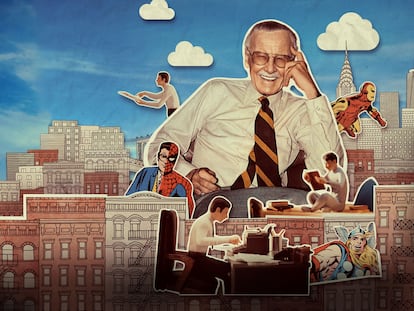From real-life Quidditch tournaments to the bureaucracy of the empire in Star Wars: fans no longer just want stories, but entire worlds
The multitude of new platforms and formats feeds into the creation of fictional universes, with dozens of different plots ready to host users. But, an expert warns, ‘as fantastic as these worlds are, they must also remain credible’

None of the real-life quidditch teams can count on Harry Potter in their squad. Now, even if this disappoints the fans, at least it makes for a more balanced competition.
There are a few other differences from the books, starting with the fact that no one can fly. However, there are still seven players per team – each one with a broom between their legs – the hoops and an elusive little ball (the Golden Snitch). And, of course, hundreds of dedicated fans, who love the sport that J.K. Rowling invented while writing one of the most famous literary sagas in history. The next Quidditch World Cup will take place on July 15 and 16 in Richmond, Virginia.
At the tournament, there will be no wands or spells, but there’s still some magic in the events. Around the world, thousands of people love the Harry Potter novels so much that they even try to role-play as the protagonists of the books. Out of respect for their idols, they’ve even dubbed the earthly version of the game as “muggle quidditch” – that is, the term used around the Hogwarts School of Witchcraft and Wizardry to describe humans without powers.
Another word that can sum up this phenomenon is “world-building.” As the name suggests, this artistic action involves the creation of worlds, because while adventures, heroes and villains remain attractive, the real triumph today is the notion of building an entire fictional universe. These invented worlds must still be credible, with passersby, festivities, governments, foods and other details. They must act as settings for hundreds of stories, in all formats. Ultimately, one falls in love with this other world to the point of setting up handball tournaments that involve brooms.
“With the rise of new digital media and streaming platforms, the demand for more immersive stories has increased. It’s not enough to captivate with unforgettable characters or plots – it’s necessary that [these characters and stories] take place in a world that’s rich in details, with its own history, rules and culture. It must be consistent enough to be told in different mediums or different narrative forms, while, at the same time, fans can expand that universe themselves,” sums up Helena Mas, an associate professor at the Open University of Catalonia, in Barcelona. She is also the creator of WHODUNITER, a firm that invents role-playing and mystery games for companies and organizations. “The worlds are already planned from the beginning, to be exploited in various formats,” adds Carlos Scolari, a professor at the Pompeu Fabra University in Barcelona. He’s an expert in transmedia narratives – another term that’s in vogue in the sector.
The concept may actually have always existed, as Alejandro Martínez – editor of Panini Comics, which publishes Marvel comics in Spain – points out. He argues that the Odyssey expands the universe of the Iliad, while Wagner needed four operas to complete The Ring of the Nibelung. Scolari recalls that the Italian novelist and medievalist Umberto Eco already spoke of “narrative worlds.”
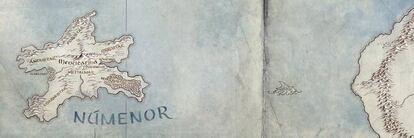
The skyrocketing increase in demand for these worlds, however, is a more recent phenomenon. As is the presence of film producers at book fairs, or the creation of new professions that have to do with transmedia: using multiple media formats to tell one story. One just needs to look to Disney to see how iconic brands have proliferated around world-building: Lucasfilm, Marvel, Pixar, Fox.
Thus, while HBO produced A Song of Ice and Fire – the saga where George R. R. Martin describes epic and intrigue, but also secondary aspects of each city and civilization, from architecture to creeds – special pains were taken to get all the details right. The adaptation of the novels – Game of Thrones – even hired experts to invent the languages that some of the characters spoke. Now, The House of the Dragon is bringing another epic from the same world to the screen, which occurred centuries earlier. Its premiere coincided – in ambition and release dates – with The Rings of Power, based on the immense fantasy created by Professor J. R. R. Tolkien, who noted down even the smallest details of Middle-earth. The avid reader of The Lord of the Rings can find (in its appendices) the spelling of certain invented words, or the House of Durin’s family tree. And today – thanks to the universe created by George Lucas 45 years ago – the Star Wars franchise can dedicate a series like Andor to the underworld and the bureaucracy of the Galactic Empire, or develop video games that take place in parts of the universe that were never previously narrated in the original movies.
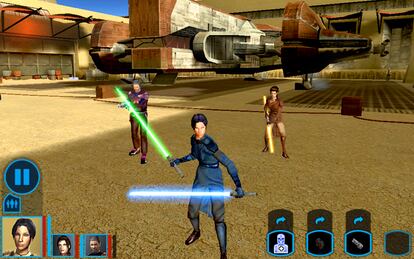
“I usually start by looking through books, magazines, Wikipedia. What will the politics [in this world] be like? Urbanism? Landscape? And, as I start to write, even the smallest details emerge: the clothes, the festivals, what the markets smell like. The idea is to help the reader feel transported to that place,” explains Marissa Meyer, author of bestsellers such as The Lunar Chronicles. She has been baptized as the “queen of retelling,” as she takes classics like Cinderella and sets them in a dystopian future. Meyer has noticed that, in meetings with producers for possible adaptations – some already underway – her world-building becomes “an advantage.”
Stan Lee, on the other hand, followed a different path. Instead of taking the reader on a journey, he brought the superheroes home. “If you wanted your stories and characters to have a veneer of reality, they had to live in the real world. This is where the Marvel universe is created. [And] what happens in one comic has effects in others,” Martínez notes. Apart from the controversies about the origins of Spiderman or The Fantastic Four – of which cartoonists Steve Ditko and Jack Kirby were at least co-creators – everyone recognizes that Lee had the idea of bringing them together in New York. Thus, sooner or later, the heroes (and villains) would end up crossing paths. That spark lit a creative fire, which has spread through comics, movies, video games, TV series and action figures. The possibilities for Iron Man and company seem endless: from crossing paths with an anti-racist demonstration in Manhattan, to exploring the limits of space. There are countless alternatives, especially since the multiverse has multiplied the world-building options even further.
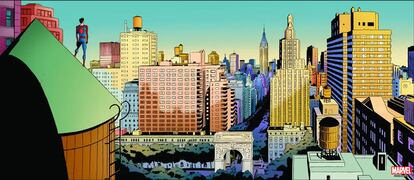
Although the imagination travels very far, recurring elements remain. “No matter how fantastic the world created is, it must be ‘believable’ and accessible to the receiver, who [should] believe everything that happens there. For this, the elements that make it up have to be coherent, within the established logic. Finally, [the fictional world] should be built out of multiple historical and visual details; [it should include] the variety of its inhabitants, cultural or geographical elements that immerse the user and make them participate, leading them to imagine being one of the people who inhabit [the world that has been built],” Helena Mas explains. Hence the maps and stories that countless fans invent for their favorite fictional universes. Or an article from The New York Times that pondered where each Marvel hero would live in New York.
In the exhibition that Pixar took on a tour of Europe, a third pillar of its highly-successful animated cinema was added to characters and plots: the world. The magic that allows viewers to see themselves reflected in the daily life of Mike Wazowski… even if he’s a blue monster who works scaring children. The company, to this day, continues to engage in world-building. “We believe in something we call immaculate reality,” says Peter Sohn, director of the recently-released Elemental. This theory was coined by George Lucas: create a world where each element has a story – even if the public never gets to know it – just to make it more credible. Sohn adds that developing the universe takes a long time at Pixar… but he emphasizes that the world that’s built must always serve the plots, not dominate them. “Whatever the character is facing, the world should serve as an echo. [It must do] justice to the message that the setting is a home for the protagonists.” Pixar has done this so well that the internet is full of fans trying to prove – based on clues hidden in each film – that Woody, Nemo, Riley or Wall.E are part of the same world. And, therefore – as Marvel teaches us – one day, they could meet.
Few companies have earned as much revenue and prestige from creating a world of their own. However, the constant interconnection has also brought problems for Marvel, such as the fact that (as fans have pointed out) the lighting and shadows in the homes of Hulk and Black Widow seem eerily similar. “You have to set limits, because if you don’t, you end up being a prisoner of your own universe. Stan Lee established that, if you found a flaw in continuity, you could cover it up with writing. In the end, it’s about maintaining a minimum internal coherence,” says Martínez.
In addition, Marvel’s policy towards creators – aimed at maintaining ownership of characters and plots – has become more controversial over time, as more money is involved than ever before, while different forms of exploitation exist. World-building may open new horizons for artists’ pockets… or it could simply result in frustration, when they see how others exploit their genius. After all, it was precisely a lawsuit over the unauthorized 1907 film adaptation of Ben-Hur: A Tale of the Christ – which was inspired by Lew Wallace’s 1880 book – that first taught Hollywood the importance of copyright law and defending authors.
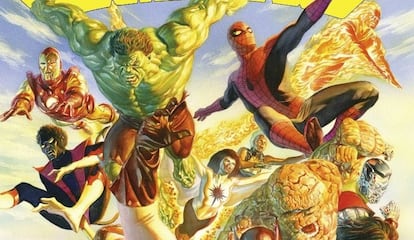
Finally, while the great Marvel sagas – where dozens of heroes come together, in movies and series such as Secret Wars, Age of Apocalypse, Onslaught or The Infinity Gauntlet – have certainly generated enthusiasm among fans, others have been bewildered: there are too many names, references and characters. Sometimes, there’s the feeling that the world matters more than the story.
All those interviewed agree that interest in creating universes runs the risk of taking focus and effort away from characters and plots. “Sometimes, it can throw you off track,” Sohn acknowledges. However, at the same time, many point out that this happens whenever a concept is successful. Martínez acknowledges that “the world of Marvel acquires such a complexity that delving into the details can be difficult. But there’s also an advantage if readers [and viewers] find themselves having some trouble: I like when a work of art looks you in the eye and doesn’t give you something too easy.”
Scolari says something similar, citing the author Steven Johnson: at the base of his bestseller – Everything Bad is Good for You – he expounds on the theory that, as popular culture has become more complex, it has, therefore, made society more intelligent. Of course, this idea is also broadly criticized… the quidditch tournament can perhaps seem magical, but also a bit delirious and silly. Luckily, there’s room for everything in this world.
Sign up for our weekly newsletter to get more English-language news coverage from EL PAÍS USA Edition
Tu suscripción se está usando en otro dispositivo
¿Quieres añadir otro usuario a tu suscripción?
Si continúas leyendo en este dispositivo, no se podrá leer en el otro.
FlechaTu suscripción se está usando en otro dispositivo y solo puedes acceder a EL PAÍS desde un dispositivo a la vez.
Si quieres compartir tu cuenta, cambia tu suscripción a la modalidad Premium, así podrás añadir otro usuario. Cada uno accederá con su propia cuenta de email, lo que os permitirá personalizar vuestra experiencia en EL PAÍS.
¿Tienes una suscripción de empresa? Accede aquí para contratar más cuentas.
En el caso de no saber quién está usando tu cuenta, te recomendamos cambiar tu contraseña aquí.
Si decides continuar compartiendo tu cuenta, este mensaje se mostrará en tu dispositivo y en el de la otra persona que está usando tu cuenta de forma indefinida, afectando a tu experiencia de lectura. Puedes consultar aquí los términos y condiciones de la suscripción digital.
More information
Archived In
Últimas noticias
New York enters the era of Zohran Mamdani
Welcome to the post-religion era: The idea of Christianity as the absolute truth has become obsolete
‘I thought you would like it’: The risky sexual practice popularized by TV shows and TikTok
The digitalization of tourism: ‘They promise experiences and gave us the worst possible one’
Most viewed
- Sinaloa Cartel war is taking its toll on Los Chapitos
- Reinhard Genzel, Nobel laureate in physics: ‘One-minute videos will never give you the truth’
- Oona Chaplin: ‘I told James Cameron that I was living in a treehouse and starting a permaculture project with a friend’
- Why the price of coffee has skyrocketed: from Brazilian plantations to specialty coffee houses
- Silver prices are going crazy: This is what’s fueling the rally


